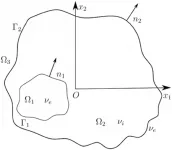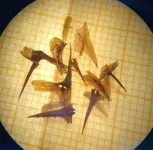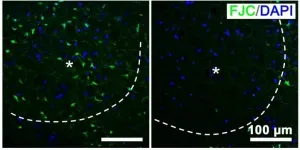Single fingerprint at a crime scene detects class A drug usage
2021-05-19
(Press-News.org) The latest findings show that with clever science, a single fingerprint left at a crime scene could be used to determine whether someone has touched or ingested class A drugs.
In a paper published in Royal Society of Chemistry's Analyst journal, a team of researchers at the University of Surrey, in collaboration with the National Centre of Excellence in Mass Spectrometry Imaging at the National Physical Laboratory (NPL) and Ionoptika Ltd reveal how they have been able to identify the differences between the fingerprints of people who touched cocaine compared with those who have ingested the drug - even if the hands are not washed. The smart science behind the advance is the mass spectrometry imaging tools applied to the detection of cocaine and its metabolites in fingerprints.
This is a step up from research previously conducted by the University. In 2020 Surrey researchers were able to determine the difference between touch and ingestion if someone had washed their hands prior to giving a sample. Given that a suspect at a crime scene is unlikely to wash their hands before leaving fingerprints, these new findings are a significant advantage to crime forensics.
The Surrey team have continued to use their world-leading experimental fingerprint drug testing approach based on high resolution mass spectrometry. Cocaine and its primary metabolite - benzoylecgonine*, can be imaged in fingerprints produced after either ingestion or contact with cocaine using these techniques. By analysing the images of cocaine and its metabolite in a fingerprint, and exploring the relationship between these molecules and the fingerprint ridges, it is possible to tell the difference between a person who has ingested a drug, and someone who has only touched it.
Dr Melanie Bailey, Reader in Forensic and Analytical Science and EPSRC Fellow at the University of Surrey, said: "Over the decades, fingerprinting technology has provided forensics with a great deal of information about gender and medication. Now, these new findings will inform forensics further when it comes to determining the use of class A drugs.
"In forensic science being able to understand more about the circumstances under which a fingerprint was deposited at a crime scene is important. This gives us the opportunity to reconstruct more detailed information from crime scenes in the future. The new research demonstrates that this is possible for the first time using high resolution mass spectrometry techniques."
Dr Allen Bellew, Applications & Marketing Manager at Ionoptika, commented: "To image these metabolites excreted through the skin requires very powerful analytical tools such as the unique Water Cluster Source that Ionoptika has been developing for over a decade. It's clear that this new technique will be important for forensic science in the future, and as a small business in the UK it's very exciting to see the role that our J105 SIMS instrument has played in its development."
Dr Chelsea Nikula, Higher Research Scientist, NPL said: "This novel application of three different techniques illustrates the capabilities of mass spectrometry imaging to enable next generation forensics analyses. It is great to see that the work we do here at NPL and the facilities we have available to us at the National Centre of Excellence in Mass Spectrometry Imaging helped support this research."
*Benzoylecgonine is a molecule produced in the body when cocaine is ingested, and it is essential in distinguishing those who have consumed the class A drug from those who have handled it.
INFORMATION:
[Attachments] See images for this press release:

ELSE PRESS RELEASES FROM THIS DATE:
2021-05-19
Problems for eigenmodes of a two-layered dielectric microcavity have become widespread thanks to the research of A.I. Nosich, E.I. Smotrova, S.V. Boriskina and others since the beginning of the 21st century. The KFU team first tackled this topic in 2014; undergraduates started working under the guidance of Evgeny Karchevsky, Professor of the Department of Applied Mathematics of the Institute of Computational Mathematics and Information Technology.
In this paper, the researchers discuss a model of a 2D active microcavity with a piercing hole and the possibility of a compromise between high directionality of radiation ...
2021-05-19
The last ice age ended almost 12 000 years ago in Norway. The land rebounded slowly as the weight of the ice disappeared and the land uplift caused many bays to become narrower and form lakes.
Fish became trapped in these lakes.
Sticklebacks managed to adapt when saltwater became freshwater, and they can still be found in today's coastal lakes along the Norwegian coast.
Saltwater gradually changed to brackish water and later to freshwater. This environmental change naturally led to a total replacement of the animal and plant life.
The exception is the tiny stickleback, which successfully adapted as saltwater became freshwater and ...
2021-05-19
A reason for these findings could be due to the fact that Parkinson's patients often also have many risk factors for a severe course of Covid-19. For the first time, the cross-sectional study provides detailed nationwide data. The research team led by Professor Lars Tönges reports in the journal Movement Disorders of 4 May 2021.
Nationwide analysis of hospital data
The team headed by Lars Tönges has analysed data on Parkinson's treatment in 1,468 hospitals. The data were taken from nationwide databases in which information on the treated diseases and of treatments carried out in hospitals is publicly collected, for example by the Institute for the Hospital Remuneration System or the Federal Statistical Office.
A comparison between the period of the first ...
2021-05-19
Blocked blood vessels in the brains of stroke patients prevent oxygen-rich blood from getting to cells, causing severe damage. Plants and some microbes produce oxygen through photosynthesis. What if there was a way to make photosynthesis happen in the brains of patients? Now, researchers reporting in ACS' Nano Letters have done just that in cells and in mice, using blue-green algae and special nanoparticles, in a proof-of-concept demonstration.
Strokes result in the deaths of 5 million people worldwide every year, according to the World Health Organization. Millions more survive, but they often experience disabilities, such as difficulties with speech, swallowing or memory. The most common cause is a blood vessel blockage in the brain, and the best way to ...
2021-05-19
WASHINGTON, DC (May 19, 2021) - Human genetics and genomics contributed $265 billion to the U.S. economy in 2019 and has the potential to drive significant further growth given major new areas of application, according to a new report issued today by the American Society of Human Genetics (ASHG). The findings indicate that this research and industry sector has seen its annual impact on the U.S. economy grow five-fold in the last decade and outlined at least eight areas of expanding impact for human health and society. ASHG commissioned and funded the report and is grateful for generous additional contributions from Invitae and Regeneron. ...
2021-05-19
An international research team led by Professor Charles Gauthier from the Institut national de la recherche scientifique (INRS) has discovered a new molecule with potential to revolutionize the biosurfactant market. The team's findings have been published in Chemical Science, the Royal Society of Chemistry's flagship journal.
Surfactants are synthesized from petroleum and are the main active ingredient in most soaps, detergents, and shampoos. Biosurfactants, produced by bacteria, are safer and can replace synthetic surfactants.
Rhamnolipid molecules are some ...
2021-05-19
Pregnant women made only modest dietary changes after being diagnosed with gestational diabetes, according to a study by researchers at the National Institutes of Health. Women with gestational diabetes are generally advised to reduce their carbohydrate intake, and the women in the study did cut their daily intake of juice and added sugars. They also increased their intake of cheese and artificially sweetened beverages. However, certain groups of women did not reduce their carbohydrate intake, including women with obesity, had more than one child, were Hispanic, had a high school degree or less, or were between the ages of 35-41 years.
The study was led by Stefanie N. Hinkle, Ph.D., of the Epidemiology Branch at NIH's Eunice Kennedy Shriver ...
2021-05-19
WASHINGTON (May 19, 2021)--Early online support for the Boogaloos, one of the groups implicated in the January 2021 attack on the United States Capitol, followed the same mathematical pattern as ISIS, despite the stark ideological, geographical and cultural differences between their forms of extremism. That's the conclusion of a new study published today by researchers at the George Washington University.
"This study helps provide a better understanding of the emergence of extremist movements in the U.S. and worldwide," Neil Johnson, a professor of physics at GW, said. "By identifying hidden common patterns in what seem to be completely unrelated movements, topped with a rigorous mathematical description of how they develop, our ...
2021-05-19
DALLAS, May 19, 2021 -- Steps to ensure safety and mitigate the spread of COVID-19 have had some unintended consequences on the management of chronic conditions such as high blood pressure, a leading cause of heart disease and health disparities in the United States. COVID-19 has disproportionately affected people from different racial and ethnic groups, those who are from under-resourced populations and communities that face historic or systemic disadvantages. Discussions and research are ongoing to address what many experts label as long-existing inequities in the U.S. health system, according to information published today in the Journal of the American Heart Association, an open access journal of the American Heart Association.
"Media coverage has examined how ...
2021-05-19
Chronic exposure to second-hand smoke results in lower body weight and cognitive impairments that more profoundly affects males, according to new research in mice led by Oregon Health & Science University.
The study published today in the journal Environmental Health Perspectives.
"The hope is that we can better understand these effects for policymakers and the next generation of smokers," said lead author Jacob Raber, Ph.D., professor of behavioral neuroscience in the OHSU School of Medicine. "Many people still smoke, and these findings suggest that that the long-term health effects can be quite serious for people who are chronically exposed to second-hand smoke."
The research examined daily exposure of 62 mice over a period of 10 months. Researchers used a specially designed ...
LAST 30 PRESS RELEASES:
[Press-News.org] Single fingerprint at a crime scene detects class A drug usage





